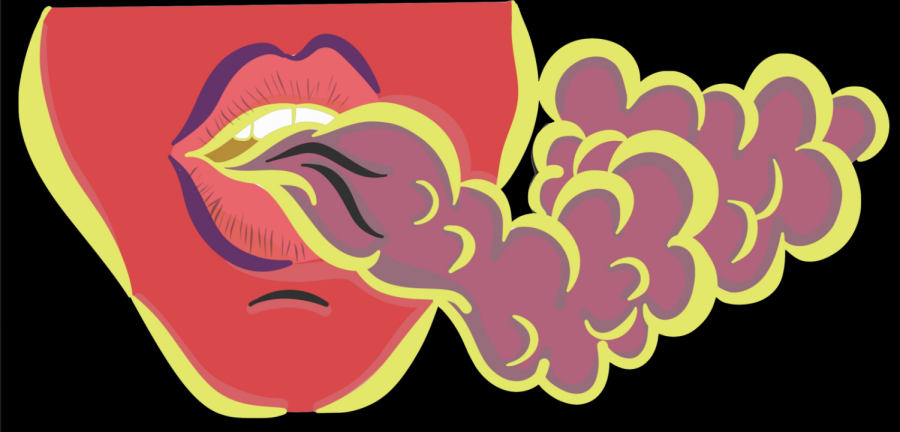Benching Nicotine
October 19, 2022
Over the last several years, the use of e-cigarettes — more commonly known as vapes — has taken the youth by storm. The sweet-smelling smoke has infiltrated school bathrooms around the nation and here at Paly.
Vapes contain nicotine, a highly addictive substance that keeps people hooked and using it long-term. Nicotine can come in many different forms, and numerous different devices such as Juuls and puff bars carry the chemical.
These devices heat the liquid nicotine until it becomes a vapor to be inhaled. There are many different vape designs, including refillable or pre-filled nicotine containers or disposable cartridges that hold the liquid. With cigarettes becoming less popular because of high state and federal taxes, as well as the negative social and physical stigma surrounding them, vapes and e-cigarettes have taken their place as a “cleaner” alternative. Although vaping is considered less harmful than cigarettes because it doesn’t deliver nicotine through healing tobacco, it is still not a healthy option. The numerous chemicals, as well as the inhalation technique of these products, still cause short and long-term damage to a person’s lungs.
This lung damage is especially harmful to athletes, who rely on strong lung capacity and endurance to thrive in their respective sports. In order to be a powerful athlete, your physical abilities, including that of your lungs, need to be in top shape –– something vaping does not promote. An anonymous Paly athlete (anonymous athlete A) who has experience with nicotine use, reflects on the negative effects it has had on their body.
“Over time, I assume that I have lost some ability of how fast and far I can run,” the student said. “My endurance has gone down.”
Other Paly athletes agree.
“I believe vaping nicotine has prohibited me from playing my sport to the best of my ability,” Another anonymous player (anoynmous athlete B) said, “Sometimes I get a sharp pain in my chest and I feel nauseous during my practice if I have been away from the nicotine for too long.”
These negative health effects would not be surprising to additional researchers. Country-wide studies have shown that vaping has serious negative side effects on an individual’s Nicotine has affected my life in many ways… I wish I never started using it. — Anonymous I have noticed that using nicotine has made my attention span decrease, especially during school — Anonymous
According to the Centers for Disease Control and Prevention (CDC), e-cigarettes and vapes contain harmful substances beyond nicotine. Vape aerosol consists of nicotine and ultrafine particles that are inhaled deep into the bronchial tree of the lungs, potentially leading to the development of cancer.
Vapes also use the chemical diacetyl for flavoring. Diacetyl is linked to serious lung disease and is only one of the many cancer-causing chemicals that are found in vapes. This can occur when the smallest airways in the lung, the bronchioles, become scarred and constricted, blocking the movement of air.
Jena Hillard is a writer for the Addiction Center Organization who focuses on educating the public on substance-abuse-related problems. In 2019, she wrote the article titled: “Vaping is Crushing the Health and Dreams Of High School Athletes.” This article mentions a study performed by Massey University about athletes who vape. In the study, they found that teens involved in team sports such as baseball, football, and hockey were the most regular users of nicotine products out of all the high school sports demographics.
“I think team sports are more likely to use vapes because of peer pressure,” anonymous athlete B said.
There are two common types of peer pressure: active and passive. Active peer pressure involved literally forcing others to perform certain activities –– like drinking or smoking. Passive peer pressure, on the other hand, is more subtle, and oftentimes more dangerous.
“Peer pressure is really present in the locker room and you can see how it affects the use of nicotine especially,” a non-nicotine-using Paly athlete said (anonymous athlete D).
In a team environment, if the athletes want to feel like they belong, they might start vaping to condor to the group or because it makes them feel like they “fit it.” Additionally, another study, done by four prestigious doctors, found that e-cigarette users are not just more likely to participate in team sports, but intramural and non-competitive sports too. The opposite, however, is true for smokers.
In the end, any athlete that uses nicotine products –– either in the form of cigarettes or their electric counterpart –– will feel the negative effects on their physical health. At Paly, the impact of the negative health effects is not only felt by the specific player, but by the whole team, leading to frustration in teammates of nicotine users.
“I think that my teammates using nicotine is really detrimental to the entire team as a whole,” anonymous athlete D said. “Seeing that in the locker room or whatnot is really just a bummer because we’re all in it [together] and taking it seriously. It just feels like they don’t value it as much.”
In addition to negatively affecting an individual’s ability and team’s performance in athletics, the addictive properties of the drug also have an insidiously harmful run-off into their academic lives.
“I have noticed that using nicotine has made my attention span decrease, especially during school,” anonymous athlete B said.
This, again, would be unsurprising to addiction –– and specifically vaping –– specialists. A study from the University of Rochester Medical Center found that vaping has a direct relationship with brain fog.
“Both adults and kids who vape were more likely to report difficulty concentrating, remembering, or making decisions than their non-vaping, non-smoking peers,” the study wrote.
But why does it distract students so much from their classroom tasks?
“Nicotine starts as being a stimulant, helping kids focus until it’s all you want to do” An anonymous Paly teacher said. “It makes students very sensitive to stress, which leads them to crave it, and also makes them more vulnerable to other addictions.”
The difficulties that nicotine brings to the classroom does not escape the notice of teachers, whose job it is to help students learn the material. An article from Addiction Prevention Coalition (APC), noted the number of teachers who felt that vaping affected their classroom environments.
“The Truth Initiative discovered that nearly 33% of teachers thought vaping affected their students’ academic performance,” the APC wrote. “Teachers reported noticing both nicotine dependence or addiction and other behavioral changes.”
In addition to hurting young adults in their respective sports, and in their respective classrooms, the detrimental effects of vaping and e-cigarettes also penetrate the mental health of users.
When the brain becomes dependent on an addictive substance, like nicotine, it cannot function without it, going into “withdrawals,” when withheld from the substance for extended periods.
These symptoms include restlessness, feeling anxious, depression, trouble sleeping, problems concentrating, and irritability. When addicts are unable to use nicotine, their attitude may become impatient and angry. This can damage relationships between those they love most, teachers, classmates, and teammates.
“Nicotine has affected a lot of my relationships because a lot of people don’t want to be around me when I vape nicotine because of their own safety concerns,” anonymous athlete B said. “My peers have expressed their concerns for me and my nicotine use and they get frustrated because I won’t listen to them.”
In 2021, through a National Youth Tobacco Survey, the CDC states that 43.6% of all high school students and 17.2% of middle school students reported using e-cigarettes on over two-thirds of the days the study was conducted. This means that almost half of high-school teens and nearly one-third of pre-teens use nicotine-related products over 60% of the time. Of those high schoolers, 27.6% reported using these products daily. The study found that overall, the vaping epidemic has allowed for 2.06 million adolescents to be currently using e-cigarettes or other nicotine products.
One of the reasons for the increase in the number of those using, and the widespread penetration of the drug is because of increasingly easy access to disposable, or reusable, products.
“It was crazy how many smoke shops would sell to you even if you were obviously under-aged,” anonymous athlete C said. “They wouldn’t even ask for your ID.”
The main reason for this lack of accountability comes from the notion and nature of our capitalist economy. Because of the for-profit system, smaller smoke shops, or bigger brands like Juul and Puff Bar, are not motivated to limit who they sell their product to: the more they sell, the more money they make.
“I think that is a big issue of the vaping epidemic because kids easily can go to smoke shops and buy vapes because the sellers don’t care about us, they just care about the revenue they make off of us,” anonymous athlete C said.
Likewise, the evil nature of the for-profit system is seen in the children-targeted ads, which come about in the form of flavored cartridges. The aforementioned study found that out of all those who used, 85.8% were using flavored e-cigarettes. This means that nearly all nicotine users are using flavored cartridges.
In 2020, California and Florida among other states, sued Juul for the way that it advertises, claiming that the colorful pallets used in the ads were catered to a younger audience. According to a 2020 lawsuit by the Massachusetts attorney general, Juul purchased ads on youth-oriented websites such as Cartoon Network and Nickelodeon, among others. Juul founders have been persistent in saying that their products are not meant for kids but as an alternative to cigarette-hooked adults. Additionally, the Food and Drug Administration (FDA) temporarily banned the sale of Juul products from the U.S. market in late June 2022. The decision was based on a lack of “sufficient evidence regarding the toxicological profile of the products”, according to the FDA. The ban has since been lifted, with the health agency claiming that they will do a review of Juul’s marketing approach.
The nicotine epidemic has affected millions of students and athletes across the country and worldwide, and although the FDA is taking steps to curb underage sales and teen-targeted ads, thousands more are getting addicted each day.
Many of those who choose to take that initial hit at some point in their adolescence feel a sense of remorse and hopelessness for what is to come in the future. Many of the anonymous users at Paly urge others to try to stop using, and better yet, to not even take that first hit.
“Nicotine has affected my life in many ways,” anonymous athlete B said. “I wish I never started using it because I am hooked.”









